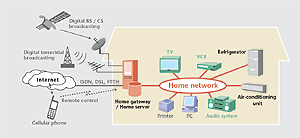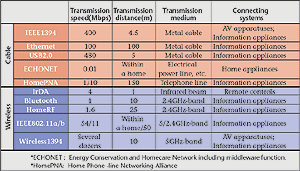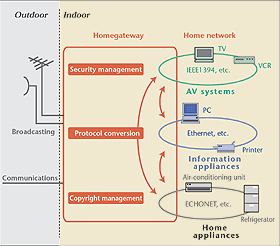Home Network Technology Trend
Much of the equipment that we use on a daily basis, such as personal
computers, printers, and AV equipment, is being equipped with a
digital communication interface. Recently, examinations have begun
on a home network system that would link not only these devices
but also home appliances. The future connection of such home networks
with broadcasting and communications networks is expected to make
the system more convenient to use. In this article, the status and
the technological trends of the home network systems are described.
|
Home network and our future lives
 |
| Figure 1: Home network |
A home network will link various AV devices and
appliances in the home as shown in Figure 1. It will further be
connected with broadcasting and communications networks via a home
gateway. The introduction of such a home network is expected to
add a variety of new applications.
For example, it will enable a home server (In-home storage)
system to be controlled from any room in the home. This will include
setting the timer for recording, replaying a recorded video,
and transferring video data in the home. Connecting a home network
with external networks will also allow easier access to a variety
of video/data services provided via broadcasting, communications,
and the Internet. Additionally, it will open up opportunities for
people to receive remote nursing, medical treatment consultation,
welfare provision and lifelong education in their homes, as well
as make community participation easier.
Another aspect of home appliance control includes lighting and air-conditioning
units. It will be possible to control these remotely from another
room or even from outside the home through a mobile terminal. For
instance, the types of operations that could be controlled from
outside will include adjusting the temperature, and turning a rice
cooker or water heater on or off. These functions are expected to
achieve energy conservation, thanks to the easier management of
home appliances.
Requirements for a home network
As mentioned above, a wide range of applications of the
home network is expected. It is therefore necessary to examine what
kinds of functions are needed for the home network. The following
conditions are important for a system in a home:
| - |
Easy connection without special skill. |
| - |
Easy wiring between rooms. |
| - |
Low cost. |
| - |
High-reliability. |
| - |
Large transmission capacity to accommodate various data,
such as video, sound, etc. |
Besides the above-mentioned requirements, international standardization
will be a crucial point for future wide diffusion.
The standardization of a home network system involves a lot of technical
elements. Examinations are now being promoted in their respective
fields. In Japan, the Digital Home-network Forum is coordinating
the results of these studies.
Digital Home-network Forum
The Digital Home-network Forum was established in July 1999, as
a esult of a TTC (Telecommunications Technology Council in Japan)
report on the "Future vision of an advanced in-home information
system and its R&D promotion strategy." In this report, the TTC
described their vision of the future home network.
This forum aims at the compilation of precise and clear proposals
from the users' standpoint on the future image of the home network,
to contribute toward its standardization. The forum has 78 participating
organizations, consisting of broadcasters, communications companies,
and home appliance and computer manufacturers.
This forum is composed of two committees, the marketing committee
and the research and development standardization committee. In addition
to grasping the market needs, the marketing committee promotes examination
of preferable user interfaces and definite applications.
The research and development standardization committee is subdivided
into four working groups, examining the following items:
| - |
Wiring, connectors, etc. |
| - |
Transmission media and transmission methods. |
| - |
Middleware. |
| - |
Home gateways. |
The next section will explain home network technology standardization
trends, featuring content examined by the forum's working groups.
Transmission media
In the home network, transmission media are classified into cable
systems and wireless systems.
Cable systems
The cable system includes optical fiber, metal cable (copper wire),
and electrical power lines, telephone lines, etc. Although optical
fiber and metal cable can transmit data at high-speed and with stability,
installation between rooms is not as easy as that of wireless systems.
The use of electrical power lines and telephone lines which have
already been installed in the home is also being examined despite
its smaller transmission capacity.
Wireless systems
Wireless systems include systems that utilize infrared beams and
radio waves at frequencies in the 2.4GHz- and 5GHz-bands. A wireless
home network system has the significant advantage of easy installation,
in comparison with cable systems.
Since infrared beams do not pass through walls, their use is limited
to within the room. Radio waves are capable of supporting mobile
communication between rooms. They, however, might suffer from radio
attenuation caused by the walls and other obstacles, resulting in
unstable transmission. This method might also raise concern over
security issues, since the transmitted data could be intercepted
by others.
Transmission method and middleware
| Table 1: Transmission methods |
 |
Transmission method
Table 1 shows individual systems connected to a home network
and their transmission methods.
The major transmission methods for cable systems using metal cables
are Ethernet or USB2.0 for information appliances, such as personal
computers, and IEEE1394 for either information appliances or AV
equipment. Wireless system transmission methods include IrDA, which
is designed for AV equipment and information appliances using infrared
beams, and Bluetooth for information appliances using radio waves.
Middleware
Networking equipment with a digital interface such as personal computers
and In-home storages, on the home network, will require a communication
protocol for mutual data exchange. The easy connection of various
devices on a network will be realized through the appropriate management
and control of each device. Therefore, the standardization of middleware,
the software serving these functions, is inevitable.
Table 2 shows the middleware for the home network. Through middleware,
mutual connectivity between systems via the network will be realized.
Furthermore, the middleware offers an automatic set up function
to make each device operable by simple connection (plug & play).
Among the connection systems for home AV equipment, IEEE1394, which
has a superior speed and data transmission stability, and HAVi,
which operates on the IEEE1394, are considered promising. HAVi is
excellent in its interconnectivity and operability. Regarding information
appliances including personal computers, the combination of Ethernet
and Jini or Ethernet and UPnP is considered highly possible. ECHONET
is considered a likely system for home appliances.
| Table 2: Home
network middleware |
| Connecting systems |
Characteristics |
|
HAVi |
AV
apparatuses |
Operation on
IEEE1394 which can transmit
stable video signals. |
| Jini
|
Information
appliances;
Home appliances |
Operable on any
apparatus with Internet
protocol. |
| UPnP |
Information
appliances;
Home appliances |
*HAVi: Home Audio/Video interoperability 
*UPnP: Universal Plug and Play  |
Home gateway
 |
| Figure 2: Home gateway function and structure |
The functions and structure of a home gateway are
shown in Figure 2. The home gateway manages each device connected
to the home network, in addition to linking the home network with
external networks.
In the case of information exchange among AV devices, information
appliances and home appliances with different properties, the home
gateway also provides protocol conversion.
Other functions of the home gateway include copyright management
and security management, preventing unauthorized access by a personalized
authorization mechanism.
Issues for the home network and its future
In order to realize various services by connecting different equipment
via a home network, there are still quite a few issues to be solved.
Especially important among them are issues regarding security and
copyright protection. A mechanism that protects personal information
and further excludes harmful information from the network will be
needed.
Easy and high-speed digital copying will be available via the home
network. This will raise the need for content providers to have
a copy control system that is well- equipped against unauthorized
copying.
A home network will transmit and control a massive flow of information.
This might cause interference wave leakage when power lines and
telephone lines are used. As a broadcaster, we need to ensure that
this should not interfere with radio broadcasting services.
A home network is an extremely effective system for downloading
massive amounts of data from various media. Future advanced information
services provided by broadcasting and communication networks will
be easily available anywhere, at home and outside, with the installation
of such a home network.
(Keigo MAJIMA, Recording Technology & Mechanical Engineering)
|
|





